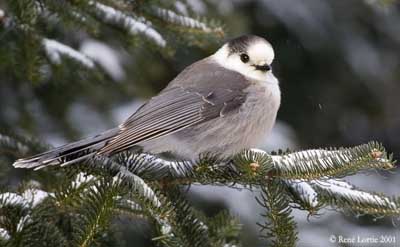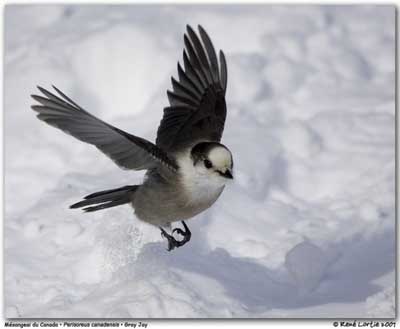
Grey Jay
Perisoreus canadensis
Passeriforme Order – Corvidae Family
BIOMETRICS:
Length: 25-33 cm
Wingspan: 45 cm
Weight: 70 g
LONGEVITY: Up to 19 years
DESCRIPTION:
Grey Jay has grey upperparts, sometimes with bluish sheen, and long tail. Wings are short and rounded. Underparts are whitish. It has white collar, but it lacks crest. Face, forehead, chin and throat are white. Crown and nape are blackish. Downy parts of plumage are silky and fluffy. Some feathers size 50 to 65 millimetres in length, providing protection against the cold.
Black bill is short. Eyes are black. Legs and feet are black.
We can find three subspecies:
P.c. canadensis
P.c. capitalis with paler crown and pale head
P.c. obscurus with larger and darker cap, and paler underparts than in other subspecies.
Both sexes are similar.
Juvenile of all races are sooty grey, with a faint white moustache, and pale bill, pink at the base, then light grey to the black tip.
DIET:
Grey Jay feeds on beetles, caterpillars, grubs and ants eggs. It may eat infertile eggs in its own nest, but also berries, seeds and buds of firs.
During winter, Grey Jay feeds on meat and fat. It may scavenge carrion and frequent dumps and campsites.
PROTECTION / THREATS / STATUS:
Grey Jay has some predators, such as falcons and hawks, and during nesting period, the owls. Mammals may attack chicks, and eat the eggs. They are squirrels, martens, porcupine and raccoons.
Other corvids, such as raven and crows, may attack nests.
Fr: Mésangeai du Canada
All : Meisenhäher
Esp : Arrandejo gris
Ital : Ghiandaia grigia canadese
Nd : Canadese Gaai
Sd : Gra lavskrika
Photographs by René Lortie
His website : http://rlortie.ca/
Text by Nicole Bouglouan
Sources:
FIELD GUIDE TO THE BIRDS OF NORTH AMERICA - National Geographic Society - ISBN: 0792274512
BIRDS OF THE GREAT BASIN – by Fred A. Ryser - Univ of Nevada Pr -ISBN: 0874170796
Wikipedia (Wikipedia, The Free Encyclopedia)
Animal Diversity Web (University of Michigan Museum of Zoology)
Birds of Nova Scotia (Robie Tufts)
All About Birds (Cornell Lab of Ornithology)

VOICE: SOUNDS BY XENO-CANTO
Grey Jay’s call includes a whistle “wheeoo” and a low “chuf-chuf-weef”. Its alarm call is very rough “kreh-kreh-kreh-kreh”. It may mimic sounds. It utters a large variety of noises, with soft whistles, melodious songs, but also sharp and harsh noises. It may be a prolonged and musical performance.
HABITAT:
Grey Jay inhabits forested areas in United States. It lives in coniferous and mixed forests in boreal subalpine regions. It doesn’t live in urban areas, because it is a bird of remote forests.
RANGE:
Grey Jay is resident from the tree line in northern Canada and Alaska to Newfoundland, southwards to northern California, Arizona and New Mexico in Rocky Mountains, northern Wisconsin in Midwest, and New York in the east.
BEHAVIOUR:
Grey Jay hops on the ground in bouncy movements. It may hop from one branch to others upwards, in spiral to the treetop. It is often seen alone or in pairs, but after the nesting period, we can see it in flocks of several families.
Grey Jay is almost tame with humans. It may take food from hands.
Juveniles are divided in two groups. The dominant brood member expels others from territory. At about two months of age, they fight among themselves for staying with parents after breeding season. If they can remain with adults, they have more chances to survive than others. Food resources stored by parents in their territory help the young to survive.

Pairing activities begin by ‘begging behaviour”, with one bird crouching, shivering wings and bill stretched towards its mate. They only perform a light touch with bills. When nesting period approaches, this behaviour intensifies, and one of the birds gives some food to its mate, always in the same position. We can also observe mutual preening. Grey Jay mates for life, but if one dies, the other mates again.
To feed, Grey Jay can pick insects while flying, as a flycatcher. It may harass other birds to leave their catch.
Grey Jay has large salivary glands, and sticky saliva, which allows impregnating the food. Then, this food will adhere to trees, and the bird may hide food among leaves and needles, into bark crevices. They may make about 1000 caches in a day. But this behaviour allows them to adapt and inhabit hostile boreal areas in winter.
FLIGHT:
Grey Jay flies softly and soundless among trees. It rarely crosses large open spaces, but if it does it, its flight is flapping and direct.
REPRODUCTION:
Breeding season starts in March, when snow covers the ground and weather is very cold, and ends by mid-May.
Grey Jay’s nest is often located in spruces or balsam firs (Abies balsamea), at one to 9 metres of high. They place it close to trunk.
Bowl-like nest is bulky. They build the outer nest with dry sticks and dead leaves. They may add some fine materials, such as shells of cocoons, part of wasps’ nests, and spiders’ web interwoven. Then, we find a thick layer of bark (cedar or willow). Nest is lined with fine grasses, hair (from deers and hares), and sometimes with feathers and their own down.
Female lays 3 to 4 pale greenish or grey-green eggs, finely spotted with olive. Incubation lasts about 16 to 18 days, by female.
Chicks hatch altricial, and are fed by both parents, by semi-digested food at first. Male feeds them while female broods the chicks. But later, she feeds them with the male and they clean the nest.
Young fledge at about 22 to 24 days of age, learning to fly, and fed by parents during 2 or 3 weeks more.
This species produces only one brood per season.
